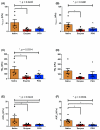Biomechanical Restoration Potential of Pentagalloyl Glucose after Arterial Extracellular Matrix Degeneration
- PMID: 31277241
- PMCID: PMC6783915
- DOI: 10.3390/bioengineering6030058
Biomechanical Restoration Potential of Pentagalloyl Glucose after Arterial Extracellular Matrix Degeneration
Abstract
The objective of this study was to quantify pentagalloyl glucose (PGG) mediated biomechanical restoration of degenerated extracellular matrix (ECM). Planar biaxial tensile testing was performed for native (N), enzyme-treated (collagenase and elastase) (E), and PGG (P) treated porcine abdominal aorta specimens (n = 6 per group). An Ogden material model was fitted to the stress-strain data and finite element computational analyses of simulated native aorta and aneurysmal abdominal aorta were performed. The maximum tensile stress of the N group was higher than that in both E and P groups for both circumferential (43.78 ± 14.18 kPa vs. 10.03 ± 2.68 kPa vs. 13.85 ± 3.02 kPa; p = 0.0226) and longitudinal directions (33.89 ± 8.98 kPa vs. 9.04 ± 2.68 kPa vs. 14.69 ± 5.88 kPa; p = 0.0441). Tensile moduli in the circumferential direction was found to be in descending order as N > P > E (195.6 ± 58.72 kPa > 81.8 ± 22.76 kPa > 46.51 ± 15.04 kPa; p = 0.0314), whereas no significant differences were found in the longitudinal direction (p = 0.1607). PGG binds to the hydrophobic core of arterial tissues and the crosslinking of ECM fibers is one of the possible explanations for the recovery of biomechanical properties observed in this study. PGG is a beneficial polyphenol that can be potentially translated to clinical practice for preventing rupture of the aneurysmal arterial wall.
Keywords: aneurysm; aorta; biomechanics; enzyme; pentagalloyl glucose.
Conflict of interest statement
The authors declare no conflict of interest. The funders had no role in the design of the study; in the collection, analyses, or interpretation of data; in the writing of the manuscript, or in the decision to publish the results.
Figures







Similar articles
-
Pentagalloyl Glucose-Laden Poly(lactide-co-glycolide) Nanoparticles for the Biomechanical Extracellular Matrix Stabilization of an In Vitro Abdominal Aortic Aneurysm Model.ACS Appl Mater Interfaces. 2021 Jun 9;13(22):25771-25782. doi: 10.1021/acsami.1c05344. Epub 2021 May 24. ACS Appl Mater Interfaces. 2021. PMID: 34030437
-
Animal Model Dependent Response to Pentagalloyl Glucose in Murine Abdominal Aortic Injury.J Clin Med. 2021 Jan 9;10(2):219. doi: 10.3390/jcm10020219. J Clin Med. 2021. PMID: 33435461 Free PMC article.
-
Pentagalloyl Glucose (PGG) Prevents and Restores Mechanical Changes Caused by Elastic Fiber Fragmentation in the Mouse Ascending Aorta.Ann Biomed Eng. 2023 Apr;51(4):806-819. doi: 10.1007/s10439-022-03093-x. Epub 2022 Oct 6. Ann Biomed Eng. 2023. PMID: 36203118 Free PMC article.
-
Biaxial mechanical properties of porcine ascending aortic wall tissue.J Heart Valve Dis. 2002 Sep;11(5):680-6; discussion 686-7. J Heart Valve Dis. 2002. PMID: 12358405
-
Advancements in identifying biomechanical determinants for abdominal aortic aneurysm rupture.Vascular. 2015 Feb;23(1):65-77. doi: 10.1177/1708538114532084. Epub 2014 Apr 22. Vascular. 2015. PMID: 24757027 Review.
Cited by
-
Review of Machine Learning Techniques in Soft Tissue Biomechanics and Biomaterials.Cardiovasc Eng Technol. 2024 Oct;15(5):522-549. doi: 10.1007/s13239-024-00737-y. Epub 2024 Jul 2. Cardiovasc Eng Technol. 2024. PMID: 38956008 Review.
-
Pentagalloyl glucose (PGG) partially prevents arterial mechanical changes due to elastin degradation.Exp Mech. 2021 Jan;61(1):41-51. doi: 10.1007/s11340-020-00625-1. Epub 2020 Jul 15. Exp Mech. 2021. PMID: 33746235 Free PMC article.
-
Ex Vivo Regional Mechanical Characterization of Porcine Pulmonary Arteries.Exp Mech. 2021 Jan;61(1):285-303. doi: 10.1007/s11340-020-00678-2. Epub 2021 Jan 7. Exp Mech. 2021. PMID: 33814554 Free PMC article.
-
Aortic Aneurysm: Finding the Right Target.Biomedicines. 2023 May 3;11(5):1345. doi: 10.3390/biomedicines11051345. Biomedicines. 2023. PMID: 37239016 Free PMC article.
-
Binding of Pentagalloyl Glucose to Aortic Wall Proteins: Insights from Peptide Mapping and Simulated Docking Studies.Bioengineering (Basel). 2023 Aug 7;10(8):936. doi: 10.3390/bioengineering10080936. Bioengineering (Basel). 2023. PMID: 37627822 Free PMC article.
References
-
- Samarth S.R., Santanu C., Judy S., Christopher B.W., Satish C.M., Ender A.F., Jose F.R. Biological, geometric and biomechanical factors influencing abdominal aortic aneurysm rupture risk: A comprehensive review. Recent Pat. Med. Imaging. 2013;3:44–59.
Grants and funding
LinkOut - more resources
Full Text Sources
Other Literature Sources

